
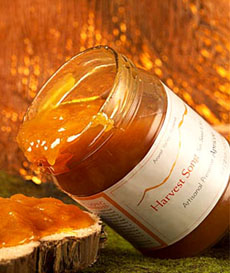 |
| Harvest Song’s apricot jam was declared the most outstanding jam or preserve of 2006 by the specialty food trade. |
|
KAREN HOCHMAN is Editorial Director of THE NIBBLE™.
|
|
November 2006
|
 |
Harvest Song Preserves
Armenian Preserves From Mt. Ararat
CAPSULE REPORT: When there’s a chill in the air and the days are shorter, one can find consolation in the fruits of the fall harvest. Harvest Song’s old-style European preserves, using recipes from the days when sugar was used sparingly, are imported from Armenia, where farmland and labor are still affordable. That means a large jar is just $8.00. And unlike the same old, same old, there are interesting variations not easily found here.
The complete Harvest Song review is below. If you’d like to try your own hand at preserves and pickled walnuts, here are some excellent books.
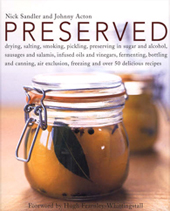 |
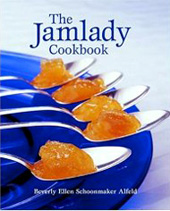 |
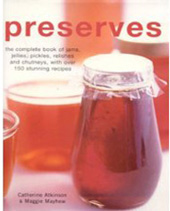 |
| Preserved, by Nick Sandler. Preserved contains everything you could wish to know on drying, salting, smoking and pickling. Elegantly written with excellent recipes, including one for your own preserved walnuts. $29.95. Click here for more information or to purchase. |
The Jamlady Cookbook, by Beverly Ellen Schoonmaker Alfeld. A food-preparation reference guide with useful information on everything from the cultivation of plants and new techniques in jamming. $23.80. Click here for more information or to purchase. |
Preserves: The Complete Book of Jams, Jellies, Pickles and Preserves, by Catherine Atkinson. Make beautiful jams and jellies for yourself or for gifts. You might not want to give them away, though! $23.80. Click here for more information or to purchase. |
Singing In The Harvest: Harvest Song Preserves
There are people who enter the specialty food business through special callings. James Tufenkian, founder of Tufenkian Artisan Carpets, is the world’s leading designer and 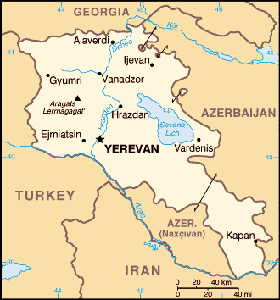 supplier of Armenian and Tibetan rugs. An American of Armenian grandparentage, he wanted to use his business skills to help Armenia’s economic revival. Harvest Song Ventures, his year-old company with co-founder and native Armenian Sylvia Tirakian, introduces indigenous Armenian products to the United States. At the 2006 Summer Fancy Food Show®, their Apricot Preserve was chosen as Outstanding Jam, Preserve, Spread or Sweet Topping by the NASFT* jurors among all entrants in the show. supplier of Armenian and Tibetan rugs. An American of Armenian grandparentage, he wanted to use his business skills to help Armenia’s economic revival. Harvest Song Ventures, his year-old company with co-founder and native Armenian Sylvia Tirakian, introduces indigenous Armenian products to the United States. At the 2006 Summer Fancy Food Show®, their Apricot Preserve was chosen as Outstanding Jam, Preserve, Spread or Sweet Topping by the NASFT* jurors among all entrants in the show.
*The National Association of Specialty Food Trades, NASFT.org, presents the Fancy Food Shows uniting manufacturers of specialty foods with retail buyers and distributors. Map of Armenia from the Central Intelligence Agency's World Factbook, public domain.
The Republic of Armenia, a former Soviet Republic, is landlocked in the southern Caucasus mountains. If one knows Armenia only by its preserves, one can’t help but envision a beautiful country where the land yields magnificent fruit—the way fruit used to be grown in our own country, before it was hybridized to be shelf-durable at the expense of flavor. You can visualize the proud Armenian farmers bringing in the harvest, and farm wives making small batches with recipes handed down through generations. You don’t need printed material to paint the picture. With just one taste, your eyes open wide and you see the whole history of these amazing preserves. One wants prosperity for Armenia, but not the kind that produces so many of the indistinct products made on our own shores.
The story becomes even more melodious when one discovers that Harvest Song Foods  are grown in the valley of Mount Ararat (photo at right), with bubbling springs and a history as old as the Book of Genesis. The twin-peaked Mt. Ararat (their outline is used in the company’s logo) is said to be where Noah’s Ark came to rest when the Great Flood receded, between the Great Peak and the Little Peak. The fruit in Harvest Song preserves has an exceptional past: according to the Bible, Noah descended from Mount Ararat and planted the very first fruit tree. Amid broad green pastures and expansive meadows covered in multicolored wildflowers, the fruits are grown at 1400 to 1800 meters above sea level, in pure air. The fertile land and clear spring waters give Armenian fruit a lush and succulent taste—you’ll notice it from your first spoonful of preserves. are grown in the valley of Mount Ararat (photo at right), with bubbling springs and a history as old as the Book of Genesis. The twin-peaked Mt. Ararat (their outline is used in the company’s logo) is said to be where Noah’s Ark came to rest when the Great Flood receded, between the Great Peak and the Little Peak. The fruit in Harvest Song preserves has an exceptional past: according to the Bible, Noah descended from Mount Ararat and planted the very first fruit tree. Amid broad green pastures and expansive meadows covered in multicolored wildflowers, the fruits are grown at 1400 to 1800 meters above sea level, in pure air. The fertile land and clear spring waters give Armenian fruit a lush and succulent taste—you’ll notice it from your first spoonful of preserves.
What’s The Difference Between Jelly, Jam, Preserves and Conserves?
A preserve contains large chunks of fruit or whole fruit, differing from smooth-textured jam and from jelly, which is both smooth and clear. To learn more, read our Jam & Jelly Glossary, one of more than 40 exclusive NIBBLE glossaries on topics from A (Antioxidant Foods) to Z (or at least, to Y, Yogurt). Take a look at all of our food glossaries—they can keep a food-lover fascinated for hours. |
The Flavors Of Harvest Song
With thirteen varieties, one has to start somewhere. Here are our favorites.
Quince Preserves. Quince is a tough fruit to deal with, literally and figuratively. That’s why it’s not often found on these shores. It can’t be eaten raw, and thus loses in economic popularity to fruits that can multitask. But that makes finding anything quince a greater pleasure. The taste of cooked quince is plum married to rose (quince is a member of the rose family)—not floral but sophisticated and masculine rose. This preserve is more jam-like: quince must be made workable in a purée. Small pieces of fruit, not necessarily visible to the eye, add texture. Dark caramel in color, it can be used as a spread, as a dessert sauce on ice cream, on a pate sandwich with foie gras mousse or chicken liver mousse, with cold poultry sandwiches, as a condiment on a plate with hot poultry, with waffles or pancakes. No matter how you use it, quince is a prince.

Back to Index
|
Apricot & White Cherry Preserves. We think that the apricots married to sweet white cherries are even more interesting, from both textural and flavor points of view, than the award-winning plain Apricot. The sweet flavor of the cherries plays off against the tartness of the apricot, just as their roundness is a counterpoint to the flat apricot flesh. In our book, this one’s the winner.
Pumpkin & Apple. Perfect for the fall season, rustic sweet chunks of delicate pumpkin and apple are not only a perfect match—they show that preserves are not just for breakfast. These are wonderful on a turkey sandwich or as a condiment with any grilled hot or cold poultry. And what a special combination—where else will anyone find this flavor? At $8.00, with their jaunty rice paper cap, they’re a perfect small holiday gift or stocking-stuffer.
|
Tea-Rose Petal Preserves. “Please don’t eat the daisies,” playwright Jean Kerr beseeched, but people have been eating roses for many centuries. Fragrant, delicate rose petals with a velvety texture make a very exotic preserve for the foodie who likes something different. Popular on toast in Greece and Turkey, they make a gourmet topping for ice cream and sorbet.
In addition to preserving fruits for spreads, Harvest Song makes two specialty items.
Yellow Pear Tomato Pickles. Tiny, sweet pear or “teardrop” tomatoes can be used as garnishes in any number of dishes, or simply as delicious snacks. In a piquant broth infused with hints of peppercorn, garlic, bay leaf and fresh dill, they are simply delicious. They can be skewered for cocktail or sandwich garnishes, sprinkled in salads, mixed with mozzarella balls, artfully arranged on luncheon or dinner plates, or used like a savory version of a maraschino cherry to top mashed potatoes, fish fish filets...the artistic applications are endless.
|
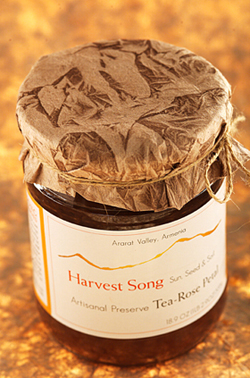
You may never have heard of Tea-Rose Petal preserves, but you’ll never forget these. Try them with Constant Bliss cheese. |
Walnut Preserve. These walnuts are preserved, but they’re not a jam. They’re whole, cooked, spiced nuts. It is not easy to find preserved walnuts—they’re a specialty of Armenia and Scandinavia, where they’re enjoyed with cheese. The preserved walnuts look like small plums: dark and gleaming. The taste is very special: the texture is like fruit, the flavor is spiced. They evoke the idea of the British sugarplum, which is a small, sugary candy but should be something more special, like this. No lover of fine foods should pass these up. They make a very special gift to food-loving friends. Make ice cream with them—cut them into pieces and mix them into vanilla, fig or caramel ice cream—or simply use them as topping.
Cheese Condiments
Like fruit pastes (the classic Spanish membrillo and others), preserves make wonderful pairings with cheese. You can read our extensive article on cheese condiments and cheese and condiment pairings, but here are some specific suggestions for Harvest Song, chosen by New York’s cheese restaurant and cheese shop, Artisanal Fromagerie And Bistro. As with anything, do your own experimenting.
- Abbaye de Belloc Cheese / Pumpkin & Apple Preserves
- Bouc Emissaire Cheese / Quince Preserves
- Constant Bliss Cheese / Tea Rose Petal Preserves
- Le Moulis Cheese / Apricot Preserves
- Monte Enebro Cheese / Apricot with Cherry Preserves
- Parmigiano Reggiano Cheese / Apricot Preserves
- Piave Cheese / Pear & Apple Preserves
- Robiola La Rossa Cheese / Strawberry Preserves
- Stilton Cheese / Walnut Preserves (THE NIBBLE adds: and a glass of Port; also serve these walnuts with Camembert, Gruyere and Feta)
|
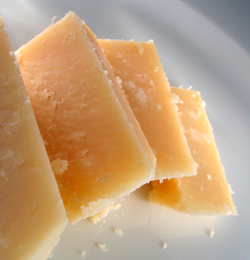
For dessert, try some Parmigiano-Reggiano with
Harvest Song’s award-winning Apricot Preserves.
|
The large jars (18.9 ounces) encourage you to eat your fill. The tops are decorated in sun-dried rice paper from Katmandu, in the colors of the harvest—russet, green-gold and earth tones.
HARVEST SONG
Apple & Pear, Apricot, Apricot & White Cherry, Golden Figs, Quince, Peach, Pumpkin & Apple, Sour Cherry, Tea-Rose Petals, Walnut, Wild Strawberry, Yellow Pear Tomato
Purchase online at
HarvestSongVentures.com
Available at specialty stores
nationwide.
Prices and flavor availability are verified at publication but are subject to change. |
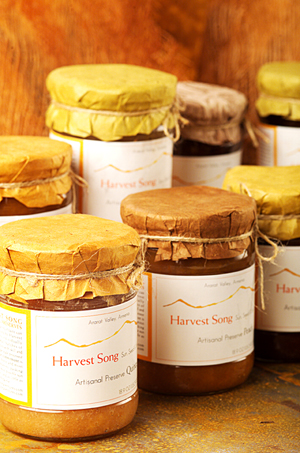 |

|








 supplier of Armenian and Tibetan rugs. An American of Armenian grandparentage, he wanted to use his business skills to help Armenia’s economic revival. Harvest Song Ventures, his year-old company with co-founder and native Armenian Sylvia Tirakian, introduces indigenous Armenian products to the United States. At the
supplier of Armenian and Tibetan rugs. An American of Armenian grandparentage, he wanted to use his business skills to help Armenia’s economic revival. Harvest Song Ventures, his year-old company with co-founder and native Armenian Sylvia Tirakian, introduces indigenous Armenian products to the United States. At the  are grown in the valley of Mount Ararat (photo at right), with bubbling springs and a history as old as the Book of Genesis. The twin-peaked Mt. Ararat (their outline is used in the company’s logo) is said to be where Noah’s Ark came to rest when the Great Flood receded, between the Great Peak and the Little Peak. The fruit in Harvest Song preserves has an exceptional past: according to the Bible, Noah descended from Mount Ararat and planted the very first fruit tree. Amid broad green pastures and expansive meadows covered in multicolored wildflowers, the fruits are grown at 1400 to 1800 meters above sea level, in pure air. The fertile land and clear spring waters give Armenian fruit a lush and succulent taste—you’ll notice it from your first spoonful of preserves.
are grown in the valley of Mount Ararat (photo at right), with bubbling springs and a history as old as the Book of Genesis. The twin-peaked Mt. Ararat (their outline is used in the company’s logo) is said to be where Noah’s Ark came to rest when the Great Flood receded, between the Great Peak and the Little Peak. The fruit in Harvest Song preserves has an exceptional past: according to the Bible, Noah descended from Mount Ararat and planted the very first fruit tree. Amid broad green pastures and expansive meadows covered in multicolored wildflowers, the fruits are grown at 1400 to 1800 meters above sea level, in pure air. The fertile land and clear spring waters give Armenian fruit a lush and succulent taste—you’ll notice it from your first spoonful of preserves. 


